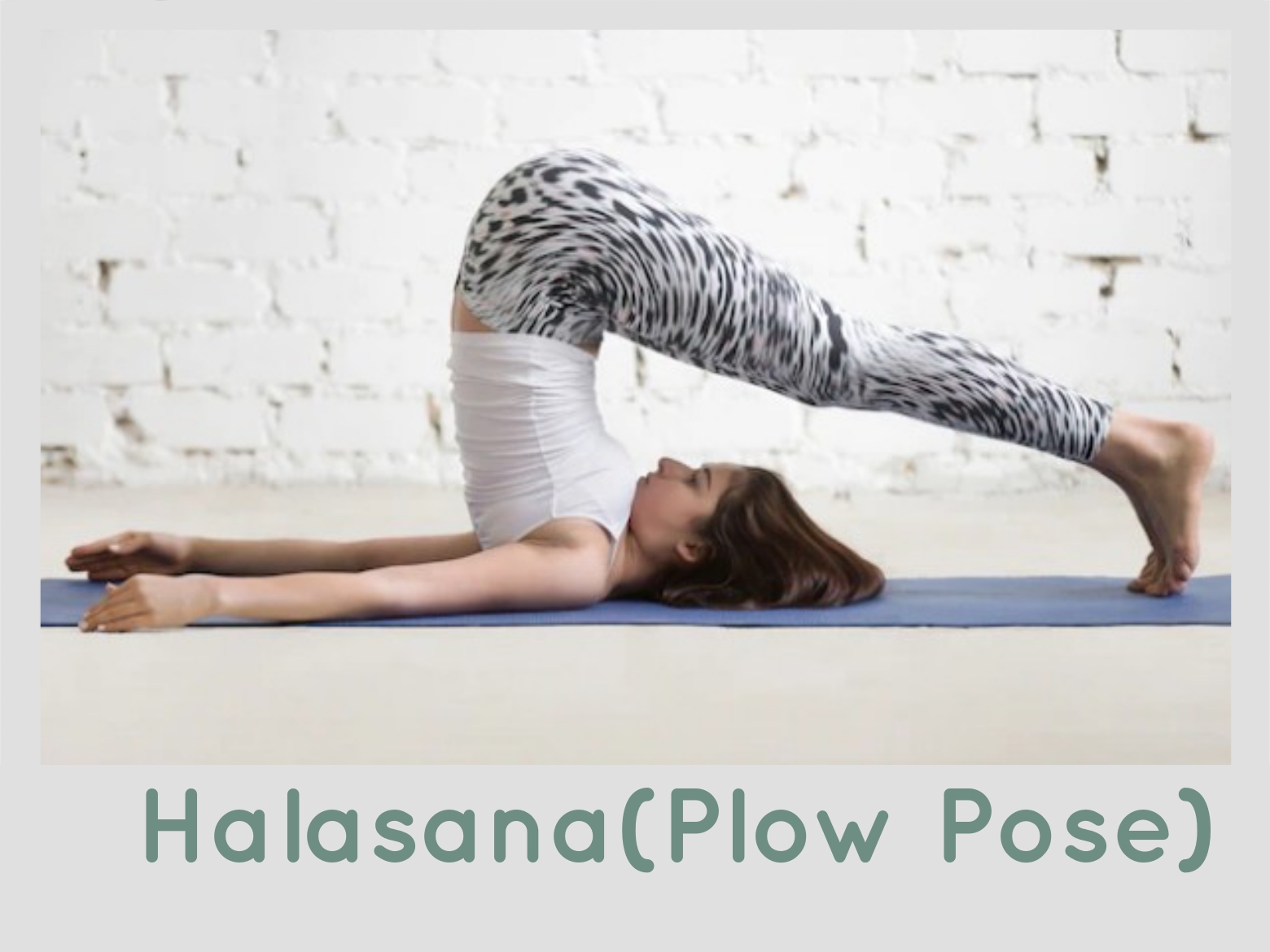Halasana (Plow Pose)
This asana is called Halasana because in its final pose the body resembles the Indian plough. also known as Plow Pose, is a yoga asana that involves lying on your back and lifting your legs over your head to bring them down toward the floor behind you. The pose resembles a plow, which is where its name comes from.
Halasana provides various benefits, including stretching the spine, shoulders, and hamstrings, stimulating the abdominal organs, and improving digestion. It is considered to be a calming and rejuvenating pose that can help relieve stress and fatigue.

How to do Halasana (Plow Pose)
♦ Lie straight on a mat or blanket and keep both arms straight at the bottom
♦ While taking a deep breath, raise both the legs upwards and make an angle of 90 degrees.
♦ After this, while exhaling, move the legs towards your head and try to bring the knees closer to the forehead.
♦ When the legs stop bending, bend the elbows and support the palms by placing them under the waist.
♦ Slowly move the hands towards the upper end of the waist so that your hips can go up as high as possible
♦ When the toes of both feet start touching the floor, keep this posture for about two minutes.
♦ After this, while exhaling, remove the palms and slowly straighten the spine and bring the legs down.
Benefits of Halasana (Plow Pose)
(1) Increasing Digestive Power: Performing Halasana improves digestion, due to which your food is digested well.
(2) Helps in reducing waist fat: It helps in reducing your waist fat and makes the waist curvy.
(3) Strengthens the muscles of the back and thighs: Halasana strengthens the muscles of the back and thighs, which increases the stability of the body.
(4) Remove thyroid problems: It helps in handling the work of thyroid gland.
(5) Reduce headache and sleep problems: Performing halasana reduces headache and sleep problems.
(6) Increasing Mindfulness: It helps in providing peace and stability to your mind.
(7) Purifying action: Halasana can help purify your body and helps cleanse your blood.
(8) Helps in reducing stress: It can help in improving your mental state and reduces stress.
(9) Helpful in cleaning the navel: By doing Halasana, your navel can be cleaned and comes in its right position.
(10) Improves body flexibility: It can help in making your body flexible and boost your physical ability.
(11) To reduce obesity:
If you are overweight or increasing belly fat, then Halasana can be very beneficial for you. With the regular practice of Halasana, the excess fat of the stomach is reduced rapidly and the stomach starts to look very flat.
(12) For Hair Growth:
Halasana is also excellent for hair. By doing Halasana, the blood reaches the roots of the hair properly, due to which the hair becomes strong and hair fall stops. Along with Halasana, Shirshasana is also a great yoga for hair. If you are troubled by the problem of hair, then definitely practice these two yogasanas.
Halasana (Plow Pose) Contraindications
Halasana should be performed with the following precautions:
1. If you have any kind of injury, avoid Halasana.
2. Pregnant women should avoid Halasana.
3. Consult a doctor before performing Halasana for cervical problems or back pain.
4. Do not stop breathing while doing Halasana, and follow proper breathing.
5. Open the whole body slowly, and when coming out, come back slowly.
6. When you come out of Halasana, place your feet gently on the ground.
7. If you have any kind of back injury, avoid doing Halasana.
Frequently Asked Questions
What are the benefits of Halasana?
Spine Flexibility: It stretches and strengthens the entire spine, promoting flexibility and relieving stiffness. Shoulder and Neck Release: The pose helps release tension in the shoulders and neck, reducing stress and improving posture. Stimulation of Abdominal Organs: It stimulates the abdominal organs, aiding digestion and improving metabolism.
Which gland is benefits by Halasana?
Halasana, also known as Plow Pose in yoga, benefits the thyroid gland. It is believed to stimulate and balance the thyroid function, which can be beneficial for overall health and metabolism.
Who should not practice Halasana?
People with neck or spine injuries: The pose puts significant pressure on the neck and spine, which can be harmful for those with pre-existing injuries or conditions.
Which Asana after Halasana?
After practicing Halasana, it is recommended to perform a counterpose to release the tension and bring the body back to a neutral position. One commonly practiced counterpose after Halasana is Matsyasana, also known as Fish Pose. Matsyasana helps to stretch and open the chest and throat, providing a nice counterbalance to the forward bending nature of Halasana.
Does Halasana reduce belly fat?
Halasana (Plow Pose) is a yoga asana that involves stretching and toning the abdominal muscles.
- Benefits of Chaturanga Dandasana (Four Limbed Staff Pose)
- Ustrasana (Camel Pose)- Benefits, Steps & Precautions
- Gorakshasana (Cowherd Pose) Benefits & Steps
- Benefits of Bakasana (Crane Pose)- Steps|Precautions
- Naukasana (Boat Pose)- Steps & Benefits
- What is Shashankasana (Rabbit Pose)?- Steps & Benefits